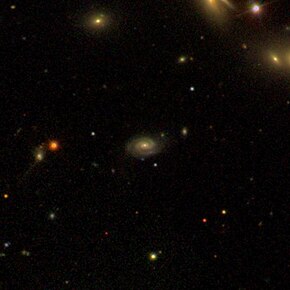The topic of this article may not meet Wikipedia's notability guideline for astronomical objects. Please help to demonstrate the notability of the topic by citing reliable secondary sources that are independent of the topic and provide significant coverage of it beyond a mere trivial mention. If notability cannot be shown, the article is likely to be merged, redirected, or deleted.Find sources: "NGC 2688" – news · newspapers · books · scholar · JSTOR (April 2024) (Learn how and when to remove this message)
| NGC 2688 | |
|---|---|
 | |
| Observation data | |
| Constellation | Ursa Major |
| Redshift | 0.05204 0.00001 |
| Heliocentric radial velocity | 15,190 km/s |
| Distance | 758 Mly (232.4 Mpc) |
| Apparent magnitude (V) | 15.8 |
| Characteristics | |
| Type | Sb |
| Size | 154,000 ly |
| Other designations | |
| PGC 25048, 2MASX J08551161+4907218, MCG+08-16-040, SDSS J085511.60+490721.3 | |
NGC 2688 is a spiral galaxy located in Ursa Major.[1][2][3] It is located 758 million light-years away from the Solar System and is moving away at a speed of 15,190 km/s.[4] NGC 2688 was found by R.J. Mitchell who was an Irish astronomer and assistant to William Parsons.[5] When Mitchell first saw the object, he commented it as very small and faint. According to Professor Seligman, the galaxy is classified as a lenticular galaxy rather than a spiral galaxy.[5]